|
|
|
|
|
Intel Core I7: Nehalem Arrives |
|
Join the community - in the OCAU Forums!
|
Basic System Readings, Benchmarks
BASIC SYSTEM READINGS AND SYNTHETIC BENCHMARKS
Both Core i7 systems were properly recognized by their names and as running with 8 threads by Vista Device Manager, the updated CPU-Z 1.48 version, and other utilities.
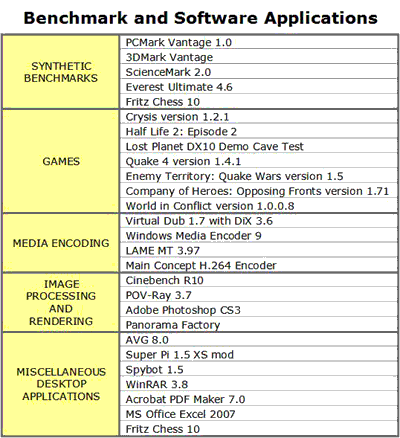
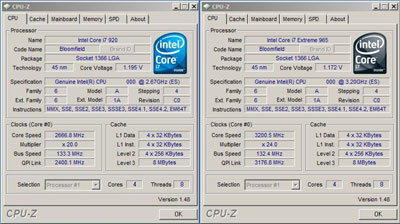
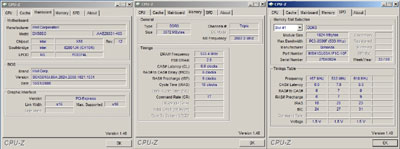
As to be expected, thanks to the on-die memory controller bandwidth has massively improved with the Core i7 systems. The Everest memory benchmark shows Core i7 with double the bandwidth than QX9770. The Core i7 system is also far ahead of any other listed system. The QX9770 based on Intel’s previous generation front-side bus design is absolutely no match in this regard. Not less important: Memory latency is been greatly reduced. It goes down from 62.1ns to 39.0ns. We can see similar massive gains in both CPU benchmarks. ScienceMark and Everest show in almost each of the 12 subtests the Core i7 system much ahead of the QX9770. PCMark Vantage runs scripted applications and is therefore much closer to “real world” usage than CPU or memory benchmarks. The subtests show again the Core i7 systems much better performing than the QX9770. The overall PPMark score has the i7 965 around 14% ahead of the QX9770.
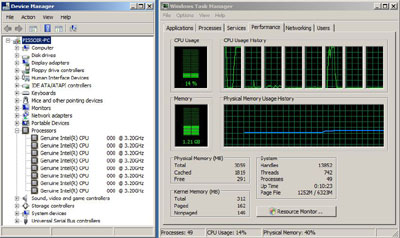
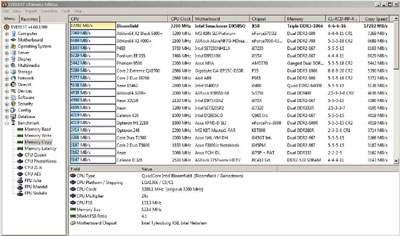
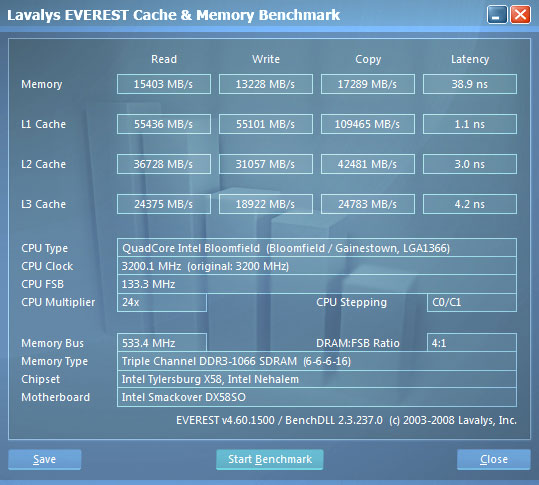
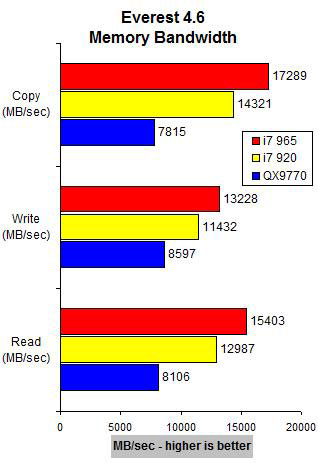 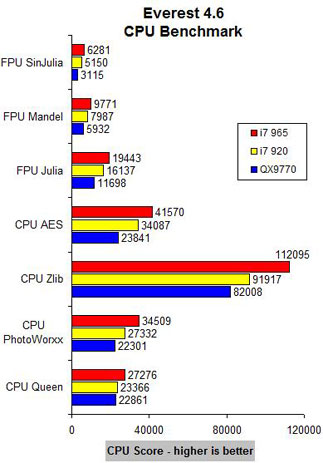
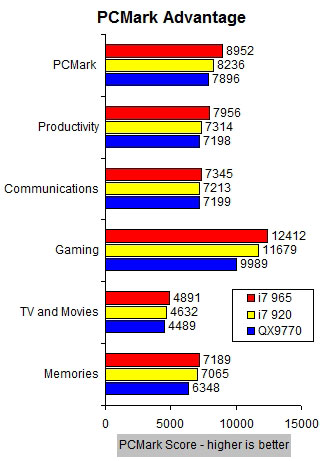 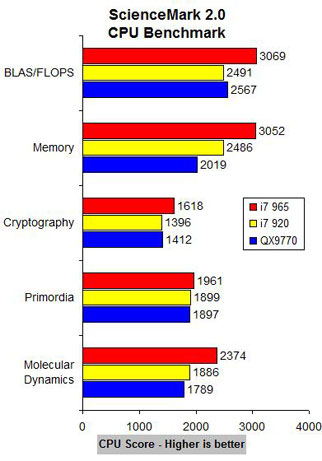
TRIPLE VERSUS DUAL CHANNEL DDR
Nehalem’s on-die memory controller supports 3-channel DDR3. Using 3 matching memory modules allows the CPU to access data across each of the memory channels by interleaving. In theory interleaving greatly reduces the latencies of waiting for memory to return data and improves bandwidth. How is the actual impact? We checked it out with Everest and then with Super PI. Super Pi is known to be very “memory sensitive”. Already small changes to the memory timings can have an impact on the calculation time. As you can see, there is a considerable difference between 1-channel and 2-channel mode. The bandwidth improves by around 14% and Super Pi is around 6% faster. On the other hand, the difference between 2-channel and 3-channel mode is far smaller, just 1.7% for Super Pi. Memory manufacturers will be most grateful for this feature, as it provides a good reason to purchase a new DDR3 kit.
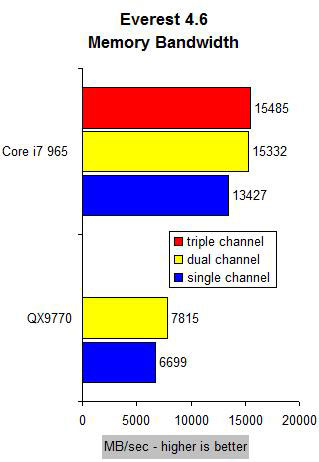 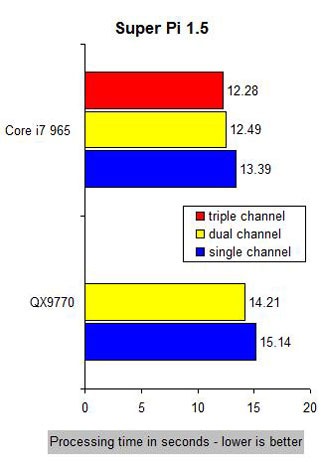
MEDIA ENCODING
“Windows Media Encoder 9” is running multithreaded and therefore making good use of a quad-core processor. We transcoded a 9 MB AVI video clip into a 39 MB WMV file. Both Core i7 systems perform better than the QX9770. “Main Concept” was used to transcode a 40 MB AVI file into the H.264 codec using one of the build-in encoding profiles. The i7 965 is 28% faster than the QX9770 system. We used “Virtual Dub” as front-end for DivX to encode a 70 MB MPEG2 source file. The i7 965 is providing around 15% better performance than the QX9770 system. We went on to transcode a 112 MB WAV file to MP3 with the multithreaded version of LAME. The i7 965 did this 17% faster. We can see a trend that will continue through all tests: Even the i7 920 running at “only” 2660 MHz is faster than the QX9770 at 3200 MHz. And the more the test applications are running multithreaded, the bigger the difference between the Core i7 systems and the QX9770 system becomes.
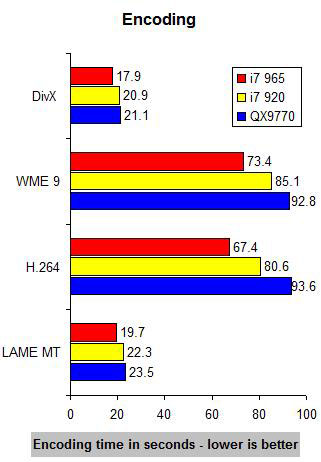
IMAGE PROCESSING
Rendering and image processing tasks are easily broken down into parallel running jobs. They are therefore an ideal working ground for a multi-core processor and SMT. “Cinebench R10” comes with a built-in benchmark. A predefined picture is rendered either single-threaded or with as many threads as cores are available. The Core i7 systems are unbeatable in this test, because Cinebench R10 takes advantage of every additional core, and SMT comes fully into play here. The i7 965 has a massive lead of more than 28%. “Panorama Factory” stitches individual images together to create a wide-aspect panorama. We asked the application to “stitch” 4 large, 1920x1080 photos with 3 MB each, into a single panorama. The QX9770 is processing the 4 pictures in 28.3 seconds; the i7 965 is finishing the job in 22.6 seconds. This is 20% faster. There isn’t much to explain about Adobe’s “Photoshop”. It’s probably the most popular image editing software around. We are applying 4 filters to a 75 MB picture. The i7 965 is around 25% faster than the QX9770 system.
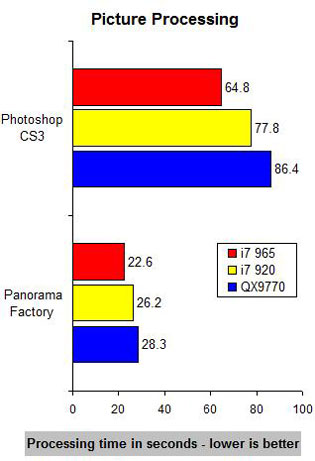 
The “Persistence of Vision Raytracer”, in short “POV-Ray”, is a ray tracing program for creating 3D-graphics. POV-Ray 3.7 comes with native multithreading. The built-in benchmark shows the Core i7 965 exactly 50% faster than the QX9770.
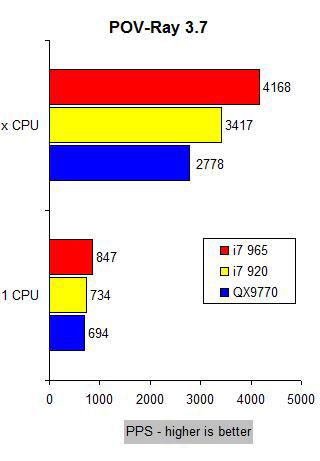
DESKTOP JOBS
We asked “AVG” to viruscheck a 100 GB hard disk drive with around 90,000 objects, Adobe’s “PDFMaker” to transfer a 36-pages PowerPoint file into a PDF document, and “SpyBot” to scan a fully occupied 100 GB hard disk drive for spyware and Trojans. For WinRAR we used the built-in compression benchmark. AVG, SpyBot, and PDFMaker are running around 15% faster with Core i7. WinRAR 3.8 can be configured for multithreading. And then it flies with Core i7. We recorded the biggest difference among all tests with WinRAR. The i7 965 system is a whooping 73% faster than the QX9770. Finally we checked out the well known and much loved “Super Pi” benchmark. The i7 965 beats the QX9770 by around 14%.
 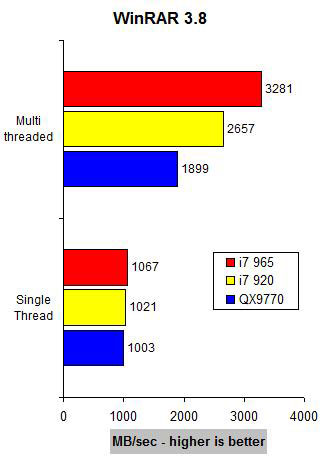
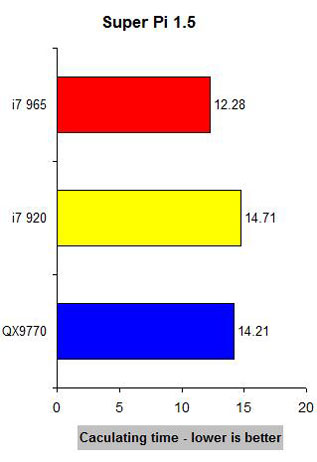
We finally ran 2 Excel 2007 benchmarks provided by Intel specifically for the evaluation of Core i7. Both are real world simulations. We assume of course that Intel has scripted them in a way showing the potential of the new platform. The first Excel benchmark is simulating common office calculations. Intel describes it as follows: “A finance worker wants to make some calculations in Excel on a large data set. Calculations including arithmetic operations like addition, subtraction, division, rounding and square root. Also includes common statistical calculations.” The Core i7 965 is running this benchmark in 3.6 seconds, 29% faster than the QX9770 system. The second Excel 2007 benchmark is running a financial analysis, called “Monte Carlo Simulation”. This is how Intel describes it: “A financial analyst wants to compute the expected prices of stock options using the Black Scholes formula. He needs to do a Monte Carlo simulation to help estimate the correct value.” The Core i7 965 needs 14.1 seconds to finish this analysis. This is 25% faster than the QX9770 system. Apparently both simulations allow maximum usage of multithreading.
 
An even more pronounced, almost linear scaling effect can be observed with “Fritz Chess 10”. The computational algorithm in this strategy game can be split into as many parallel threads as cores are available. The build-in benchmark shows the i7 965 with a 35% performance advantage versus the QX9770 system.
|
|
Advertisement:
All original content copyright James Rolfe.
All rights reserved. No reproduction allowed without written permission.
Interested in advertising on OCAU? Contact us for info.
|

|


